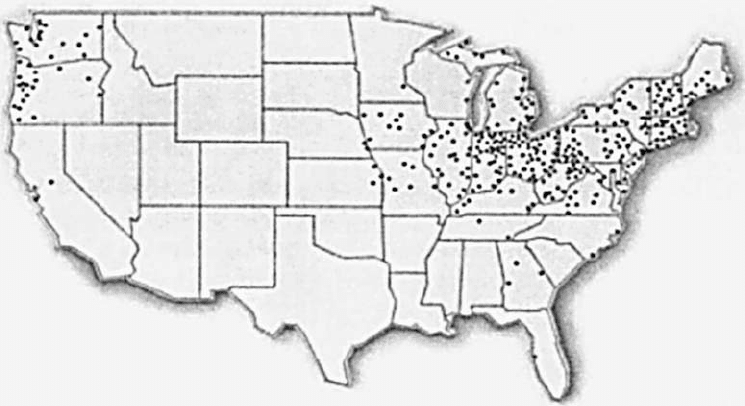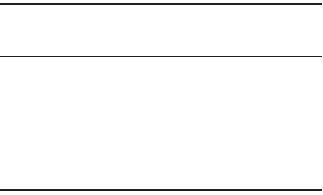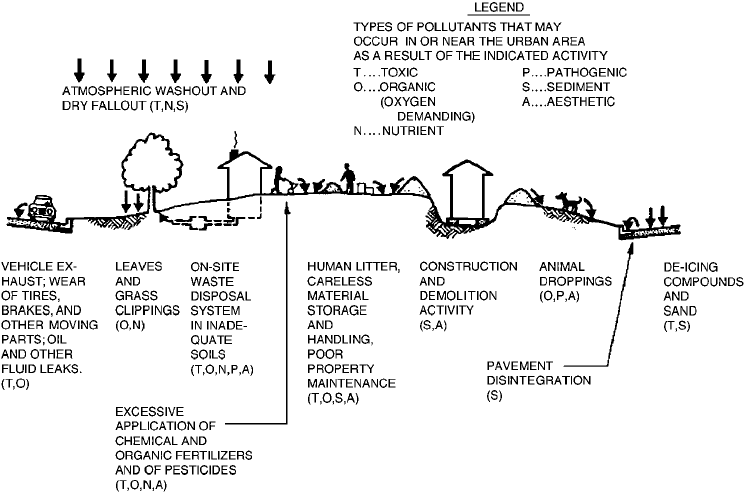Wai-Fah Chen.The Civil Engineering Handbook
Подождите немного. Документ загружается.


© 2003 by CRC Press LLC
33
Quality of Urban Runoff
33.1 Urban Runoff
Point Sources • Nonpoint Sources
33.2 Quality of Urban Runoff
Point Source Pollution • Nonpoint Source Pollution • National
Urban Runoff Program • Comparison of Pollution Sources
33.3 Water Quality Regulations and Policies
Receiving Water Guidance • Water Quality Criteria
33.4 Modeling
Modeling Categories • Data • Point Source Models • Nonpoint
Source Models • Modeling Considerations
33.5 Best Management Practices
Point Source Programs • Total Maximum Daily Loads •
Nonpoint Source Programs • Structural Measures
33.1 Urban Runoff
Urban runoff is a major environmental concern. The old paradigm of only controlling flow to mitigate
flood damage must be extended to incorporate preventing deterioration of water quality. For the purposes
of this chapter,
urban runoff
is water flowing because of urbanization and may occur from the following
sources: stormwater runoff, combined sewer overflows, sanitary sewer overflows, publicly owned treat-
ment works and industrial outfalls, and/or miscellaneous runoff. There are other sources of runoff that
contribute to the deterioration of water quality, including agricultural runoff, but those are not considered
urban sources. The major volume of urban runoff is composed of water that flows from landscaped
areas, driveways, streets, parking lots, roofs, and from other impervious surfaces.
This chapter provides an overview of the sources of urban runoff in terms of quantity and quality,
discusses water quality regulations and criteria, and shares best management practices, which often
require detailed modeling of the urban system. Relevant investigations carried out by various agencies
are included, such as NURP (National Urban Runoff Program, EPA, 1983). The TMDL (Total Maximum
Daily Load) program is discussed and should be viewed as a management practice to control the quality
of urban runoff (EPA, 2000c).
Before considering the impacts of pollution on urban water quality, the effect of urbanization on the
hydrologic cycle must be investigated. As watersheds become urbanized, hydrological characteristics
drastically change. Urbanization can result in the following changes of a catchment’s hydrologic cycle
(WEF/ASCE, 1998):
•reducing the degree of infiltration and increased runoff volumes resulting from surface changes
(altered grading, form, or cover);
•changing the available depression storage because of re-grading;
Amrou Atassi
CDM
Stephen D. Ernst
Christopher B. Burke
Engineering, Ltd.
Ronald F. Wukash*
Purdue University
* Due to the untimely death of Dr. Wukasch, this chapter was completed by his co-authors and was reviewed by
Reggie Baker of the Indiana Department of Environmental Management.
33
-2
The Civil Engineering Handbook, Second Edition
•changing evapotranspiration as vegetative cover is removed; and
•reducing the residence time of water in a catchment as a result of increased impervious areas or
the construction of efficient sewer systems.
Clearly, the main cause for increased quantity of runoff when considering similar catchments in urban
and rural areas is the increased impervious surface. Land use changes with urbanization cause average
curve numbers and runoff coefficients to increase and the time of concentration to decrease. (A table of
runoff curve numbers can be found in Chapter 32, “Urban Drainage”.) The relationship between runoff
coefficient (event runoff volume divided by event rainfall volume) and percent impervious area has been
widely studied. A 1994 study of 40 runoff-monitoring sites in the U.S. indicated that percent watershed
imperviousness is nearly equal to the runoff coefficient, and becomes a more perfect indicator of percent
runoff as imperviousness increases (Schueler, 1994).
The different hydrologic responses of developed urban areas when compared to natural or rural settings
are worth considering. Increased flow velocities are generated as excess water flows more rapidly over
impervious surfaces. Runoff volume from an impervious parking lot is 20 times that which results from a
1% impervious measure of the same flow length and slope (Schueler, 1994). The susceptibility of sensitive
catchments to development is further shown as an urban catchment generated over 250 times the peak flow
and over 350 times the suspended sediment as compared to a 20% larger rural catchment (Cherkauer, 1975).
Point Sources
The terms point and nonpoint source have been used to identify types of pollution in urban runoff. The
current statutory definition of a
point source
as defined by the Water Quality Act (U.S. Congress, 1987) is:
The term “point source” means any discernable, confined and discrete conveyance, including but
not limited to any pipe, ditch channel, tunnel, conduit, well, discrete fissure, container, rolling stock,
concentrated animal feeding operation, or vessel or other floating craft from which pollutants are
or may be discharged. This term does not include agricultural, stormwater, and return flows from
irrigated agriculture.
Typically, point source pollution can be traced to a single point such as a pipe or outfall. The main
components of urban runoff that are identified as point sources of pollution are
publicly owned treat-
ment works
(POTWs) and industrial outfalls, stormwater outfalls,
combined sewer overflows
(CSOs),
and
sanitary sewer overflows
(SSOs).
Historically, substandard effluent quality from POTWs and industrial facilities was a common occur-
rence. However, as a result of increased awareness and stricter regulations, effluents have become con-
trolled under permits and mandates. A widespread implementation of advanced treatment methods at
POTWs and industrial facilities has resulted in a higher quality of effluent. Approximately 16,000 POTWs
and tens of thousands of industrial facilities discharge treated wastewater in the U.S. Although the
wastewater has been treated, many pollutant residuals remain in the effluent and are considered contin-
uous point sources of pollution.
The improved quality of treated municipal and industrial wastewater effluent has caused other point
sources of pollution to be scrutinized. Much attention has been shifted to point sources that intermittently
“overflow” such as CSOs and SSOs. There are many possible reasons that may cause sewer systems to
overflow untreated wastewater into a receiving body and are as follows (EPA, 2001a and 2001c):
•Infiltration and Inflow: flow that infiltrates through the ground into leaky sewers during large
rainfall events and flow from various diffuse sources such as broken pipes.
•Undersized Systems: pumps and sewer piping inadequately sized to handle system demand result-
ing from increased urbanization.
•Equipment Failures: pumps and controls either fail or are inoperable due to power outages.
•Sewer Service Connections: old or damaged sewer service connections to houses and buildings.
•Deteriorating Sewer Systems: may result from improper installation and maintenance.
© 2003 by CRC Press LLC

Quality of Urban Runoff
33
-3
Combined sewers were designed to convey a mixture of stormwater, infiltration, miscellaneous runoff,
and raw sanitary sewage. During dry conditions, wastewater is directed to a POTW for treatment. However,
in wet weather periods the design capacity of the combined sewer system can be exceeded. Excess water
is then discharged through a CSO directly to a receiving body such as a stream, river, lake, or ocean.
Communities with CSOs are typically found in older cities located in Northeastern and Great Lakes regions
of the U.S. Figure 33.1 not only shows a distribution of cities in the U.S. with active CSOs, but also provides
an idea of which areas are most vulnerable to pollution from CSO discharges (EPA, 2001a).
It is estimated that combined sewers serve 950 communities with about forty million people in the
U.S. Some cities have as many as 280 outfalls. CSOs discharge toxic materials, solids, and bacterial and
viral pathogens at potentially harmful levels into receiving bodies, which may be used for recreation or
drinking water. An estimated total of 15,000 CSO discharges occur annually (EPA, 2001a).
Problems with sanitary sewers also pose a threat to human health and the environment. Since sanitary
sewers are designed only to convey raw municipal wastewater to POTWs, SSOs can release raw sewage
wherever sewer pipes travel enroute to the treatment facility. Due to the nature of the waste discharged
from SSOs, exposure could result in sickness or death caused by pathogens and toxins. It is estimated
that over 40,000 SSO events occur in 18,500 municipal sewers in the U.S. annually (EPA, 2001c).
Nonpoint Sources
All sources of pollution not defined as point sources are thereby nonpoint sources.
Nonpoint source
pollution comes from many diffuse sources. Some examples of nonpoint source pollution include agri-
cultural runoff, urban runoff from sewered and unsewered communities, construction site runoff, septic
tanks, wet and dry
atmospheric deposition
, and any other activities on land that generate runoff
(Novotney et. al, 1994). Nonpoint source pollution is the main reason that 40% of the surveyed water
bodies in the U.S. are not suitable for basic uses such as fishing and swimming (EPA, 1997a). Three main
sources of nonpoint source pollution that contribute to urban runoff are stormwater runoff, shallow
groundwater runoff, and miscellaneous runoff.
Stormwater runoff is defined as surface water runoff that flows into receiving bodies or into storm
sewers. Currently only a small percentage of communities in the U.S. have stormwater runoff treatment
initiatives. Stormwater runoff poses a special concern given that pollutants buildup during dry weather
periods and then
washoff
following runoff events.
FIGURE 33.1
Map showing prevalence of CSOs in U.S. (EPA, 2001a).
© 2003 by CRC Press LLC

33
-4
The Civil Engineering Handbook, Second Edition
Shallow groundwater runoff is considered a nonpoint source of pollution given that any contaminant
in contact with subsurface water may potentially be transported to receiving water bodies. Although this
transport process appears slow, it may actually be accelerated as groundwater seeps onto impervious
surfaces or infiltrates into faulty sewer systems. This form of nonpoint source pollution has been linked
to groundwater contamination. A major nonpoint source of pollution in shallow groundwater deposits
occurs due to flawed decentralized wastewater systems.
Decentralized wastewater systems are more commonly referred to as septic systems, private sewage
systems, or individual sewage systems. A septic system works by retaining heavier solids and lighter fats,
oils, and grease and discharging partially clarified water to a distribution and soil infiltration system.
When these systems fail, it is often unnoticed and can become a significant nonpoint source concern.
States report failed septic systems as the third most common source of groundwater contamination.
Malfunctioning septic systems have been questioned as a potential source of contamination of drinking
water that is estimated to cause 168,000 viral and 34,000 bacterial infections annually (EPA, 2000b).
Other contributions to nonpoint source pollution in urban runoff can be classified as miscellaneous
runoff sources. Examples include excess water runoff from car washing or over watering of landscaped
areas. Other sources consist of flushing fire hydrants, rubbish water leaking from trash, and improperly
discarded oils. These sources are considered a major component of nonpoint source pollution, which
carry pollutants and pose a threat to the quality of urban runoff.
33.2 Quality of Urban Runoff
The EPA recognizes that urban runoff is the leading cause of current water quality problems in the U.S.
Table 33.1 provides a comparison of pollutant loadings from a hypothetical American city of 100,000
people. The data show that loadings from stormwater exceed that of the treated sewage.
Point Source Pollution
Although combined sewer systems can contain highly diluted sewage during wet weather flows, the overall
quality of discharged water remains low. A 1978 investigation by the EPA provided an analysis of pollutants
caused by CSOs. Table 33.2 shows nationwide average characteristics of CSOs. Pollutant concentrations
are lower than typical raw wastewater composition, but the numbers exceed water quality criteria and
pose an environmental threat to receiving waters. The investigation showed that CSOs contribute 15 times
the lead and suspended solids of secondary wastewater treatment discharge. In addition, coliform bacteria
are present in high quantity, potentially causing waterborne diseases in receiving communities.
Nonpoint Source Pollution
Nonpoint source pollution generated from various diffuse sources includes many pollutants, which are
finally deposited into lakes, rivers, wetlands, coastal waters, and possibly underground aquifers. These
pollutants include (EPA, 1997a):
TABLE 33.1
Comparison of Areal Loadings of Pollutants From a Hypothetical
American City of 100,000 People in tons per year (Pitt and Field, 1977)
Pollutant Stormwater Raw Sewage Treated Sewage
Total Solids 17,000 5200 520
COD 2400 4800 480
BOD
5
1200 4400 440
Total Phosphorus 50 200 10
TKN 50 800 80
Lead 31 — —
Zinc 6 — —
Reprinted from Journal AWWA, Vol. 69 (1977), by permission. Copyright
©
1977,
American Water Works Association.
© 2003 by CRC Press LLC

Quality of Urban Runoff
33
-5
•Excess fertilizers and pesticides from residential areas – These compounds when conveyed down-
stream can contribute to algal blooms and other environmental nuisances caused by
eutrophication
.
• Oil, grease and toxic chemicals from urban runoff generated from residential or industrial activities –
Oils and grease can leak onto road surfaces to be discharged into storm sewers or carried by rain
or snowmelt directly to surface waters.
•Sediment from construction sites and other urban activities are eroded from the land and trans-
ported to surface waters. This causes gradual sediment deposition in streams and lakes.
•Salt and other deicing compounds that could either be distributed on roads or stored in an urban
area. Melted snow containing salts or other deicing compounds can produce high sodium and
chloride concentrations in ponds, lakes and bays. This could also cause fish kills.
•Heavy metals which come from various sources including the natural ones, such as minerals, sand,
and rock, can degrade water quality and cause detrimental effects on aquatic life and water
resources including groundwater aquifers. Industrial runoff also contributes a high concentration
of heavy metals.
•Animal droppings, grass clippings and other urban wastes contribute bacteria and nutrients that
lead to degradation of receiving waters.
•Other constituents deposited by atmospheric deposition. The acidic nature of urban rainfall can
lead to damages in urban infrastructure and vegetation.
All pollutants contained within stormwater runoff such as toxic chemicals, heavy metals, nutrients,
litter, sediments, and other constituents can pose a threat to human health and the environment.
Figure 33.2 shows the ubiquitous nature of nonpoint source of pollution resulting from urbanization.
Collectively, nonpoint sources can potentially result in toxic, nutrient, and pathogenic pollutions in
addition to causing negative aesthetic impacts on communities (Walesh, 1989).
Nationwide Urban Runoff Program (NURP)
NURP (EPA, 1983) provided a comprehensive investigation of the quality of urban runoff and was based
on an extensive study conducted from 1978 to 1983 by the EPA and U.S. Geological Survey (USGS). The
program included 2300 storm events at 81 sites in 22 different cities throughout the U.S. The principal
conclusions quoted from NURP’s Executive Summary are:
1. Heavy metals (especially copper, lead and zinc) are by far the most prevalent priority pollutant
constituents found in urban runoff.
2. The organic priority pollutants are detected at lower concentrations than heavy metals.
3. Coliform bacteria are present at high levels in urban runoff and can be expected to exceed EPA
water quality criteria during and immediately after storm events in many surface waters, even
those providing a high degree of dilution.
4. Nutrients are generally present in urban runoff.
TA BLE 33.2
Nationwide Average
Characteristics of CSOs (EPA, 1978)
Parameter
Average
Concentration
BOD
5
(mg/l) 115
Suspended solids (mg/l) 370
Total Nitrogen (mg/l) 9–10
Phosphate (mg/l) 1.9
Lead (mg/l) 0.37
Total Coliforms (MPN/100 ml) 10
2
–10
4
© 2003 by CRC Press LLC

33
-6
The Civil Engineering Handbook, Second Edition
5. Oxygen-demanding substances are present in urban runoff at concentrations approximating those
in secondary treatment plant discharges.
6. Total suspended solids concentrations in urban runoff are fairly high in comparison to treatment
plant discharges.
The EPA adopted the following constituents as standard pollutants to characterize the quality of urban
runoff:
Using the above constituents, the study characterized the quality of urban runoff in the U.S. based on
event mean concentrations (EMC)
. EMC is the average pollutant concentration in runoff generated
from a storm event. The results consist of flow-weighted average concentrations. Table 33.3 shows water
quality characteristics of urban runoff based on a median and a coefficient of variation of the established
EMCs. The report recommended using the data for planning purposes as a description of urban runoff
characteristics.
Taking the above data and converting them to mean values produces Table 33.4, which shows EMC
mean values used in load comparison. The mean range is shown for both the median and 90th percentile
urban site. The difference in means reflects the dependence of the mean value on the coefficient of
variability used. Load comparison values indicate a combination of the previous two columns.
FIGURE 33.2
Nonpoint source pollution as a result of urbanization (Walesh, 1989).
TSS = Total Suspended Solids
BOD = Biochemical Oxygen Demand
COD = Chemical Oxygen Demand
TP = Total Phosphorus (as P)
SP = Soluble Phosphorus (as P)
TKN = Total Kjeldahl Nitrogen (as N)
NO
2+3
-N = Nitrite and Nitrate (as N)
Cu = Total Copper
Pb = Total Lead
Zn = Total Zinc
© 2003 by CRC Press LLC

Quality of Urban Runoff
33
-7
By choosing the appropriate rainfall and land use data and selecting the EMC value from Table 33.4,
the mean annual load can be estimated for the urban runoff constituents. Table 33.5 shows annual urban
runoff loads for different types of urban developments based on a 40-in. per year rainfall.
TABLE 33.3
Water Quality Characteristics of Urban Runoff
Constituent
Event-to-Event Variability
in EMCs (Coef Var)
Site Median EMC
For Median Urban Site For 90th Percentile Urban Site
TSS (mg/l) 1–2 100 300
BOD (mg/l) 0.5–1.0 9 15
COD (mg/l) 0.5–1.0 65 140
Tot. P (mg/l) 0.5–1.0 0.33 0.70
Sol. P (mg/l) 0.5–1.0 0.12 0.21
TKN (mg/l) 0.5–1.0 1.50 3.30
NO
2+3
-N (mg/l) 0.5–1.0 0.68 1.75
Tot. Cu (
m
g/l) 0.5–1.0 34 93
Tot. Pb (
m
g/l) 0.5–1.0 144 350
Tot. Zn (
m
g/l) 0.5–1.0 160 500
Source:
U.S. EPA, 1983, Vol. 1, Table 6–17, pp. 6–43.
TABLE 33.4
EMC Mean Values Used in Load Comparison
Constituent Median Urban Site
Site Median EMC
90
th
Percentile Urban Site Values Used in Load Comparison
TSS (mg/l) 141–224 424–671 180–548
BOD (mg/l) 10–13 17–21 12–19
COD (mg/l) 73–92 157–198 82–178
Tot. P (mg/l) 0.37–0.47 0.78–0.99 0.42–0.88
Sol. P (mg/l) 0.13–0.17 0.23–0.30 0.15–0.28
TKN (mg/l) 1.68–2.12 3.69–4.67 1.90–4.18
NO
2+3
-N (mg/l) 0.76–0.96 1.96–2.47 0.86–2.21
Tot. Cu (
m
g/l) 38–48 104–132 43–118
Tot. Pb (
m
g/l) 161–204 391–495 182–443
Tot. Zn (
m
g/l) 179–226 559–707 202–633
Source:
U.S. EPA, 1983, Vol. 1, Table 6–24, pp. 6–60.
TABLE 33.5
Annual Urban Runoff Loads (Kg/Ha/Year)
Constituent
Site Mean Conc.
(mg/l) Residential Commercial All Urban
Assumed Rv 0.3 0.8 0.35
TSS 180 550 1460 640
BOD 12 36 98 43
COD 82 250 666 292
Total P 0.42 1.3 3.4 1.5
Sol. P 0.15 0.5 1.2 0.5
TKN 1.90 5.8 15.4 6.6
NO
2+3
-N 0.86 2.6 7.0 3.6
Tot. Cu 0.043 0.13 0.35 0.15
Tot. Pb 0.182 0.55 1.48 0.65
Tot. Zn 0.202 0.62 1.64 0.72
Note:
Assumes 40-inches/year rainfall as a long-term average.
Source:
U.S. EPA, 1983, Vol. 1, Table 6–25, pp. 6–64
© 2003 by CRC Press LLC

33
-8
The Civil Engineering Handbook, Second Edition
Comparison of Pollution Sources
Results and conclusions from the NURP investigation clearly show the high concentration of pollutants
generated during wet weather flow. Exact loadings from different nonpoint sources can be analyzed and
compared to that of point sources, such as CSOs, SSOs and treated wastewater effluent. Table 33.6
comparatively provides additional information on the relative strengths of potential sources of point and
nonpoint source pollution within an urbanized area.
The one issue that remains critical is whether pollution exceeds water quality criteria recommended
by the EPA and enforced by state agencies. The next section will provide an overview of the water quality
regulations set forth for the protection of water bodies and present water quality criteria, which can be
compared to runoff pollution results.
33.3 Water Quality Regulations and Policies
Water quality regulations in the U.S. have evolved over the last 30 years. The following is a summary of
a few relevant federal regulations as they impact urban runoff:
•Federal Water Pollution Control Act of 1972 (PL 92–500) and the Clean Water Act (CWA)
Amendments of 1977 (PL 95–217): Under Section 208 of the Act, any discharged point source
pollution into navigable waters is prohibited unless allowed by an NPDES permit. The law gave
EPA the authority to set effluent standards on a technology basis.
•Safe Drinking Water Act (SDWA) of 1974 (PL 93–523) and 1986 Amendments regulate injection
of wastewater into groundwater aquifers. Further, it requires communities with groundwater
supply to develop a Wellhead Protection Plan (WHPP). The plan calls for the delineation of
potential sources of contamination. See also Chapter 34, “Groundwater Engineering”.
•Resource Conservation and Recovery Act (RCRA) of 1976 (PL 94–580) and Hazardous Waste
Amendments of 1984 (PL 98–616) mandate the protection of the environment from accidental
or unregulated spills of hazardous substances and leading underground storage tanks.
TABLE 33.6
Comparison of the Strength of Point and Nonpoint Urban Sources
Type of
Wastewater
BOD
5
(mg/l)
Suspended Solids
(mg/l)
Total Nitrogen
(mg/l)
Total Phosphorus
(mg/l)
Lead
(mg/l)
Total Coliforms
(MPN/100 ml)
Urban
stormwater
a
10–250 (30) 3–11,000 (650) 3–10 0.2–1.7 (0.6) 0.03–3.1 (0.3) 10
3
–10
8
Construction
site runoff
b
NA 10,000–40,000 NA NA NA NA
Combined
sewer overflows
a
60–200 100–1100 3–24 1–11 (0.4) 10
5
–10
7
Light industrial
area
c
8–12 45–375 0.2–1.1 NA 0.02–1.1 10
Roof runoff
c
3–8 12–216 0.5–4 NA 0.005–0.03 10
2
Typical untreated
sewage
d
(160) (235) (35) (10) NA 10
7
–10
9
Typical POTW
effluent
d
(20) (20) (30) (10) NA 10
4
–10
6
Note:
() = mean; NA = not available; POTW = Publicly owned treatment works with secondary (biological) treatment.
a
Novotny and Chesters (1981) and Lager and Smith (1974).
b
Unpublished research by Wisconsin Water Resources Center.
c
Ellis (1986).
d
Novotny, et al. (1989).
© 2003 by CRC Press LLC
Quality of Urban Runoff
33
-9
The Federal Water Pollution Control Act of 1972 and Amendments (CWA) in 1977 provided much
of the regulations concerning urban runoff, and govern pollutants discharged in streams, rivers, lakes,
and estuaries. The Clean Water Act maintains that all U.S. waters must be “fishable and swimmable” at
all times. Recent amendments enacted in 1987 under the Water Quality Act (PL 100–4) provided many
provisions to previous regulations due to the remaining water quality problems. These provisions include:
• Establishing a comprehensive program to control toxic pollutants.
•Requiring states to develop and implement additional programs to control nonpoint source
pollution.
•Authorizing a total of $18 billion in aid for wastewater treatment assistance.
•Authorizing additional programs and modifying previous ones to control water pollution in key
water-resource areas including the Great Lakes.
•Revising regulatory, permit, and enforcement programs.
Receiving Water Guidance
The National Urban Runoff Program (EPA, 1983) provided principle conclusions to the impact of urban
runoff on receiving waters. The effects of urban runoff on receiving waters depend on the type, size, and
hydrology of the water body, the urban runoff quality and quantity, and water quality criteria for specific
pollutants. NURP’s principle conclusions for rivers, streams, lakes, estuaries, and groundwater, quoted
from the executive summary, are:
Rivers and Streams
1. Frequent exceedances of heavy metals ambient water quality criteria for freshwater aquatic life are
produced by urban runoff.
2. Although a significant number of problem situations could result from heavy metals in urban
runoff, levels of freshwater aquatic life use impairment suggested by the magnitude and frequency
of ambient criteria exceedances were not observed.
3. Copper, lead and zinc appear to pose a significant threat to aquatic life uses in some areas of the
country. Copper is suggested to be the most significant of the three.
4. Organic priority pollutants in urban runoff do not appear to pose a general threat to freshwater
aquatic life.
5. The physical aspects of urban runoff, e.g., erosion and scour, can be a significant cause of habitat
disruption and can affect the type of fishery present. However, this area was studied only incidentally
by several of the projects under the NURP program and a more concentrated study is necessary.
6. Several projects identified possible problems in the sediments because of the build-up of priority
pollutants contributed wholly or in part by urban runoff. However, the NURP studies in the area
were few in number and limited in scope, and the findings must be considered only indicative of
the need for further study, particularly as to long-term impacts.
7. Coliform bacteria are present at high levels in urban runoff and can be expected to exceed EPA
water quality criteria during and immediately after storm events in most rivers and streams.
8. Domestic water supply systems with intakes located on streams in close proximity to urban runoff
discharges are encouraged to check for priority pollutants which have been detected in urban
runoff, particularly organic pollutants.
Lakes
1. Nutrients in urban runoff may accelerate eutrophication problems and severely limit recreational
uses, especially in lakes. However, NURP’s lake projects indicate that the degree of beneficial use
impairment varies widely, as does the significance of the urban runoff component.
2. Coliform bacteria discharges in urban runoff have a significant negative impact on the recreational
uses of lakes.
© 2003 by CRC Press LLC

33
-10
The Civil Engineering Handbook, Second Edition
Estuaries and Embayments
1. Adverse effects of urban runoff in marine waters will be at highly specific local situations. Though
estuaries and embayments were studied to a very limited extent in NURP, they are not believed
to be generally threatened by urban runoff, though specific instances where use is impaired or
denied can be of significant local and even regional importance. Coliform bacteria present in
urban runoff is the primary pollutant of concern, causing direct impacts on shellfish harvesting
and beach closures.
Groundwater Aquifers
1. Groundwater aquifers that receive deliberate recharge of urban runoff do not appear to be immi-
nently threatened by this practice at the two locations where it was investigated.
The conclusions provided by the NURP program for receiving waters can be viewed as recommenda-
tions for the abatement of pollution on receiving water bodies in an attempt to meet water quality
standards.
Water Quality Criteria (WQC)
The EPA under section 304 of the Clean Water Act (CWA) has developed recommended water quality
criteria. The criteria should provide guidance for states in selecting quality standards. The standards can
be used in implementing limits based on environmental programs, such as NPDES permits. Recom-
mended water quality criteria for selected pollutants are shown in Table 33.7.
Quality of urban runoff data given by the NURP and other investigations present a range of pollutants,
but show high concentrations of metals, suspended solids, nutrients and bacteria. The recommended
water quality criteria can be compared to the quality of urban runoff. A noticeable gap exists between
runoff concentrations and water quality criteria. This shows that additional control and treatment is
needed to improve the quality of receiving waters, which requires the development of management
practices and control plans.
33.4 Modeling
The development of control plans or management practices for urban catchments requires a detailed
understanding of all the inputs to urban runoff quality within the watershed. Modeling allows for a
greater comprehension of the integrated urban water system. For situations that are best approached
through modeling, the following rationales may be considered (WEF/ASCE, 1998):
TABLE 33.7
Recommended Water Quality Criteria of Freshwater for Selected
Point and Nonpoint Source Pollutants (Adapted from EPA 1986 and 1991)
Pollutant Acute (short-term) L.O.E.L. Chronic (long-term) L.O.E.L.
Ammonia (mg/L) 15.7 3.9
Copper (mg/L) 18 12
Lead (mg/L) 82 3.2
Zinc (mg/L) 320 47
Bacteria – E. Coli 126 per mL
Suspended solids Settleable and suspended solids should not reduce the depth of
the compensation point for photosynthetic activity by more
than 10% from the seasonally established norm for aquatic life.
DO (mg/L) 6.5 4.00
Nitrates/nitrites 10 mg/L for water supply
Phosphorus 0.10 mg/L (elemental) for marine or estuarine water
Note: L.O.E.L = Lowest Observed Effect Level
© 2003 by CRC Press LLC
